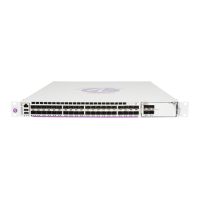Router Configuration Overview
58 7705 SAR OS Router Configuration Guide
Router Configuration Overview
On a 7705 SAR, an interface is a logical named entity. An interface is created by specifying
an interface name under the config>router context, the global router configuration
context where objects like static routes and dynamic routing are defined. An IP interface
name can be up to 32 alphanumeric characters long, must start with a letter, and is
case-sensitive; for example, the interface name “1.1.1.1” is not allowed, but “int-1.1.1.1” is
allowed.
To create an interface on an Alcatel-Lucent 7705 SAR, the basic configuration tasks that
must be performed are:
• assign a name to the interface
• associate an IP address with the interface
• associate the interface with a network interface or the system interface
• configure appropriate routing protocols
A system interface and network interface should be configured.
System Interface
A system interface is a virtual interface similar to other interfaces but with only some
operational parameters. The IP address, shutdown and no shutdown attributes are the only
operational parameters for the system interface.
The system interface must have an IP address with a 32-bit subnet mask. The system interface
is associated with the node (such as a specific 7705 SAR), not a specific interface. The system
interface is also referred to as the loopback interface. The system interface is associated
during the configuration of the following entities:
• LSP creation (next hop) — when configuring MPLS paths and LSPs
• the addresses on a target router — to set up an LDP or OSPF session between
neighbors and to configure SDPs (the system interface is the service tunnel endpoint)
The system interface is used to preserve connectivity (when alternate routes exist) and to
decouple physical connectivity and reachability. If an interface carrying peering traffic fails,
and there are alternative routes to the same peer system interface, peering could be either
unaffected or re-established over the alternate routes. The system interface IP address is also
used for pseudowire/VLL signaling (via targeted LDP).
The system interface is used as the router identifier if a router ID has not been explicitly
configured.

